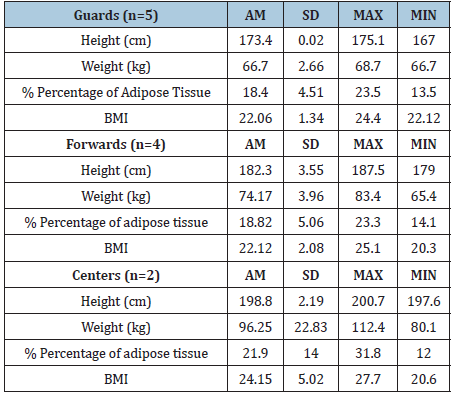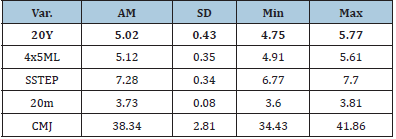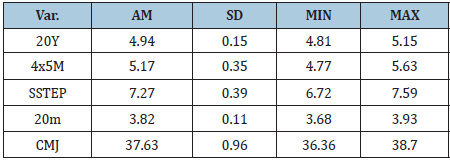- Submissions

Full Text
Research & Investigations in Sports Medicine
Anthropological Profile of Senior Croatian Basketball Players
Iva Borović1* and Gordana Ivković2
1Department of Kinesiology, Croatia
2Director of the Centre for Physical Education and Student Sport, University of Zadar, Croatia
*Corresponding author: Iva Borović, Department of Kinesiology, Croatia
Submission: December 13, 2020;Published: March 22, 2021

ISSN: 2577-1914 Volume7 Issue3
Abstract
Keywords: Anthropological profile; Senior croatian; Basketball players; Complex sports; Personality traits; Cognitive; Conative; Ball; European players
Abbreviations: AS: Arithmetic Mean; SD: Standard Deviation; MIN: Minimum Value; MAX: Maximum Value
Introduction
In terms of its structure, basketball belongs to a group of more complex sports. The game itself requires an exchange of high and low intensity activities. Along with the basic technical and tactical knowledge, the players’ success also depends on a high level of cognitive and conative personality traits as well as physical fitness and well-developed motor skills. Motor skills enable fast, strong, precise or coordinated performance of motor tasks [1]. In basketball, the most prevalent motor skills are coordination-various movement techniques performed by players with and without the ball; and agility-movement in defense, opening up for a pass, and changes of direction and pace of movement. Speed, especially reaction speed, strength and balance, that manifests during specific shot movements, have a high impact on basketball performance. The aspect of precision in basketball includes two important segments, that is, passing precision and shooting precision. Of course, shooting precision greatly determines the success in the game, but nowadays the segment of a passing precision also has a high predictive value [2-4]. After analysing the morphological characteristics from the perspective of the longitudinal and transversal dimensionality of the basketball players’ skeleton, it has been found that these characteristics play a major role and influence the performance in the game [5].
Methodology
The sample of examinees consisted of 11 senior Croatian national team players preparing for the 2012 Olympic Games in London. The participants were informed in advance, both verbally and in writing, about the way in which each test was conducted and performed as well as their purpose. All participants completed the health questionnaire prior to performing the tests and agreed to the testing. According to the positions in the game, they are categorized as 1,2 guards (n=5), 3,4 forwards (n=4), 5 centers (n=2). The sample of variables is composed of morphological characteristics and tests for the assessment of motor abilities based on valid metric characteristics [6-8] whereas the battery of tests is standardized by the diagnostic center of the faculty of Kinesiology at the University of Zagreb. Among the morphological characteristics, we measured the height and weight of the body as well as the percentage of adipose tissue (BI-TANITA BC-418), and we calculated the body mass index. The 20-yard test (MAG20Y), the side-step test (MAGSSTEP) and the 4x5 meter test (MAG4x5M) were used to assess agility, while a 20-meter test was used to assess explosive strength in sprint performance. The explosive strength in vertical jumps was estimated based on test results from the countermovement jump test (MESCMJ), which was applied by using the Kistler force platforms. Data processing was performed using the programming package Statistica for Windows, ver. 12. The following parameters were calculated for each variable: Arithmetic Mean (AS), Standard Deviation (SD), Minimum Value (MIN), and Maximum Value (MAX).
Results and Discussion
Table 1 shows the statistical descriptive parameters of the players’ measured morphological characteristics at the guard, forward and center positions. Analyzing the values obtained in the tests for determining the morphological characteristics, we can see the difference between guards, forwards and centers. From Table 1, we can notice that the height of the guards is 173.44±0.02cm and the mass is 66.7±2.66kg, which is significantly smaller than that of the forwards, which is 182.3±3.55cm and 74.17±3.96kg, and that of the centers, which is 198.8±2.19cm and 96.25kg. Nunes et al. [9] conducted an analysis of the morphological characteristics of the top senior players of the Brazilian national selection by their positions in the game. Body height values were slightly less than those of our examinees in this study-guards (171.5±4.94cm), forwards (178.2±5.06cm) and centers (191.8±4.71cm)-indicating a high population of Croatian players in all positions. On the other hand, larger variations in deviation can be observed in body mass values whereby Brazilian basketball players are much “lighter”: guards (62.5±3.53kg), forwards (72.6±7.17kg) and centers (88.56±9.97kg). Based on the average body mass index values of 22.06±1.34kg/m² for guards, forwards 22.12±2.08kg/ m² and centers 24.15±5.02kg/m², according to the World Health Organization classification, this group has a normal body weight, as expected [10]. At the centers position we found a slightly larger deviation, but still within the normal range. This is because we only have 2 examinees who are very different in terms of morphological characteristics. Morphological characterization studies were conducted by Berdejo-del-Fresto et al. [11] on the English Premier League players in the top 4 teams by their positions in the game. Looking at the body mass values of the English Premier League players, with the exception of the guards with 22.42±1.37kg/ m², the forwards with 24.21±2.69kg/m² and the centers with 29.96±6.25 kg/m² had a higher body mass index in comparison to our basketball players. Moreover, the centers position’s figures were even concerning.
Table 1:Descriptive statistical parameters of morphological characteristics of guards, forwards and centers.

Source: AM: Arithmetic Mean; SD: Standard Deviation; MIN: Minimum; MAX: Maximum; BMI: Body Mass Index
Table 2:Descriptive statistical indicators of the results achieved in tests for the assessment of motor skills - guards.

Source: AM: Arithmetic Mean; SD: Standard Deviation; MIN: Minimum Value; MAX: Maximum Value; 20Y: The 20-Yard Test; 4x5ML: The 4x5 Meter Test with Ball; SSTEP: The Side-Step Test; 20m: 20-Meter Sprint Test; CMJ: Countermovement Jump Test
The percentage of adipose tissue in Croatian basketball players at the guard position is 18.4±4.1%, followed by the forwards with 18.82±5.06% and the centers with 21.9±14.0, which are satisfactory values considering that they are female seniors. The English basketball players had slightly lower values at the guard position with 16.9±1.65% and the centers with 21.24±1.78%, while the forwards had a slightly higher value 20.19±0.78%. However, it should be noted that the English Premier League is not in the top five to six European leagues and, therefore, the best European players do not perform in the league. The optimal percentage of adipose tissue allows for a large number of quick and intense movements in defense and attack, as it has been proven in numerous studies so far that the excessive amount of adipose tissue can adversely affect speed, agility and endurance 2016; [12,13]. Basketball, in terms of motor skills, is dominated by agility (changes of direction of movement with the ball, movements in defensive stance etc.), explosive power of the upper and lower extremities (vertical jump, passes), balance, precision of passing and shooting, speed (starting speed and acceleration) etc. According to Šimunović et al. [14-20], agility is defined as the ability to slow down, accelerate and change the direction of movement while maintaining good body control. It is closely related to balance because it requires the player to continuously transfer the center of gravity of the body, due to the specific movements of the game itself, such as movement in the defensive stance or opening to receive the ball (Tables 2-4). The results obtained by the test assessing the frontal-nimble agility (20Y) indicate variation in terms of players’ position in the game. The players at the center position achieved the highest scores, which in this test means that they were actually the slowest, and their average result was 5,44±0,55sec. The players at the guard position achieved the average result of 5,2±0,43sec, whereas the fastest players in this test were those at the forward position with 4,94±0,15sec. In the side-step test (SSTEP) used for assessing the lateral agility, the most agile players were those at the forward position (7,28±0,39sec), then the guards (7,27±0,34sec) and then the centers (8,04±0,57sec). On the basis of these results, it can be concluded that players at the forward position are more agile than those at the center, whereas there is little deviation in comparison to the guards. In the specific basketball 4x5-meter test we also notice a significant difference in terms of position between inner and outer circle players. The best scores were achieved, as expected, by players at the guard position (5,12±0,35sec), followed by forwards (5,17±0,35sec), whereas the lowest scores were achieved by players at the center position (5,93±0,35sec).
Table 3:Descriptive statistical indicators of the results achieved in tests for the assessment of motor skillsforwards.

Source: AM: Arithmetic Mean; SD: Standard Deviation; MIN: Minimum Value; MAX: Maximum Value; 20Y: The 20-Yard Test; 4x5ML: The 4x5 Meter Test with Ball; Step: The Side-Step Test; 20m: 20-Meter Sprint Test; CMJ: Countermovement Jump Test
Table 4: Descriptive statistical indicators of the results achieved in tests for the assessment of motor skills-centers.

Source: AM: Arithmetic Mean; SD: Standard Deviation; MIN: Minimum Value; MAX: Maximum Value; 20Y: The 20-Yard Test; 4x5ML: The 4x5 Meter Test with Ball; SSTEP: The Side-Step Test; 20m: 20-Meter Sprint Test; CMJ: Countermovement Jump Test
Erčulj et al. [21] conducted a research on the Serbian and Slovenian senior selection in relation to the motor skills of the players at different positions in the game. In assessing the explosive strength in sprint performance, the 20m sprint test was used and the results were as follows: guards 3,50±0,15sec, forwards 3,57±0,08 and centers 3,7±0,85sec. Similar research was carried out by Delextrat & Cohen [22] on the English League II. division of players who achieved the following results: guards 3,37±0,17sec, forwards 3,53±0,22sec and centers 3,59±0,26sec. This comparison shows that Slovenian, Serbian and even English League II divisions were faster than our guards (3,73±0,08sec), forwards (3,82±0,11sec) and centers (4,13±0,32sec). The successful performance of jumps in defense and attack, fast passes, and short sprints largely depend on the player’s explosive strength. In a single basketball game, the player jumps 46 times on average, which underlines the importance of the vertical jump in basketball [23,24]. In this study, we used a test for measuring the vertical jump type explosive power, Counter Movement Jump (CMJ), for evaluating the vertical jump type explosive power and we obtained the following average results: the guards achieved 38.34±2.81cm, the forwards, 37.63±0.96cm, and the centers, 35.91±11.66cm. It is surprising that the centers achieved the poorest result in this test, especially considering that they are expected to make the greatest number of jumps in a game.
Conclusion
Based on the obtained results of the observed morphological characteristics, we can conclude that there are noticeable differences in the longitudinal and transversal dimensionality of the skeleton between the guard forward-centre player positions. The collected data on the percentage of body fat indicate that all players in this specific sample of examinees have an optimal body composition with regard to the demands of the game. In almost all motor tests, the best results were achieved by guards and then forwards. The biggest differences between players in terms of their position were noticed in tests for assessing speed, agility and explosive strength. Comparing the obtained results with those of other selections, namely Slovenian and Serbian, our players are slightly legging behind. We have to take into account that, at the time, these were our best players preparing for the 2012 Olympic Games in London and they have achieved the historic success of Croatian female basketball, so the possible poor results could be due to the lack of motivation for the testing itself. However, these results can be useful in future, namely for comparison with upcoming generations.
References
- Milanović D (2010) Training theory and methodology. Faculty of Kinesiology, University of Zagreb, Social Polytechnic of Zagreb, Zagreb, Croatia.
- Borović I, Rupčić T, Matković BR, Garafolić H, Dadić M (2016) Anthropological profile of U-16 basketball players. Acta Kinesiologica 10 (1): 71-77.
- Matković BR, Matković B, Knjaz D (2005) Physiology of the basketball game. Croatian Sports Medicine Journal 20(2): 113-124.
- Matković B, Knjaz D, Rupčić T (2014) Basics of the game of basketball-a manual for monitoring the teaching of basketball. Faculty of Kinesiology, University of Zagreb, Zagreb, Croatia.
- Matkovic B, Matkovic BR (1986) Influence of morphological characteristics on basketball performance. Kinesiology 2: 95-98.
- Metikoš D, Prot F, Horvat V, Kuleš B, Hofman E (1982) Basic motor abilities of subjects with above-average motor status. Kinesiology 14(5): 21-62.
- Blašković M, Milanović D, Matković B (1982) Reliability analysis and factor validity of situational motor tests in basketball. Kinesiology 14(5): 131-149.
- Jukić I, Vučetić V, Aračić M, Bok D, Dizdar D, et al. (2008) Diagnosis of fitness of soldiers. Institute for Research and Development of Defense Systems, Zagreb, Croatia.
- Antonio NJ, Montagner PC, Mendes RD, De Rose JD, Ademar A, et al. (2008) Anthropometry, physical and technical performance of female basketball Brazilian team participant of Olympics games in Athens 2004. Brazilian Jounal of Biometricity 2(2): 109-121.
- Wilmore JH, Cotill DL, Kenney WL (2008) Body composition in sport. (4th edn), Physiology of Sport and Exercise. Human Kinetics, USA, pp. 318-327.
- Fresno BD, Amador J, Sanchez L, Gonzáles Rave JM (2012) Fitness level and body composition of elite female players in England basketball league division I. Internationl Journal of Sport and Exercise Science 4(2): 15-24.
- Apostolidis N, Nassis GP, Bolatoglou T, Geladas ND (2004) Physiological and technical characteristics of elite young basketball players. Journal of Sports Medicine and Physical Fitness 44(2): 157-163.
- Osváth P, Mészáros Z, Tóth SZ, Kiss K, Mavroudes M, et al. (2009) Physical and physiological performances in 10-year-old obese boys. Acta Physiologica Hungarica 96(4): 475-482.
- Šimunović D, Šimunović DG, Borović I, Knjaz D, Rupčić T (2017) Anthropological analysis of the Croatian U16 Basketball men's National team-A comparative analysis of two generations. 8th International Scientific Conference on Kinesiology, Europe, pp. 411-414.
- Brown LE, Ferrgano VA, Santana JC (2004) Speed agility explosiveness. Gopal Zagreb, Croatia.
- Arthur M, Bailey B (1998) Agility drills. Chapter 7 in Complete Conditioning for Football Champaign, Human Kinetics, IL, USA, pp. 191-237.
- Brittengam G (1996) Athleticsm for basketball. Chapter 5 in Complete Conditioning for Basketball. Champaign, Human Kinetics, IL, USA, pp. 69-87.
- Costello F, Kreis EJ (1993) Introduction to agility. Chapter 1 in Sports Agility. Taylor Sports Publishing, UK, pp. 2-3.
- Murphy P, Forney J (1997) Agility training. Chapter 7 in complete conditioning for basketball. Human Kinetics, Champaign, IL, USA, pp. 126-136.
- Smythe R (1995) Acts of agility. Training and Conditioning 4: 22-25.
- Erčulj F, Braić M, Jakovljević S (2011) The level of speed and agility of different types of elite female basketball players. Facta Universitatis 9(3): 283-293.
- Delextrat A, Cohen D (2009) Strength, power, speed and agility of women basketball players according of playing position. The Journal of Strength & Conditioning Research 23(7): 1974-1981.
- Rouis M, Coudrat L, Jaafan H, Filliard JR, Vandewalle H, et al. (2015) Assessment of isokinetic knee strength in elite young female basketball players: Correlation with vertical jump. J Sports Med Phys Fitness 55(12): 1502-1508.
- McInnes SE, Carlson JS, Jones CJ, McKenna MJ (1995) The physiological load imposed on basketball players during competition. J Sports Sc 13(5): 387-397.
© 2021 Iva Borović. This is an open access article distributed under the terms of the Creative Commons Attribution License , which permits unrestricted use, distribution, and build upon your work non-commercially.
 a Creative Commons Attribution 4.0 International License. Based on a work at www.crimsonpublishers.com.
Best viewed in
a Creative Commons Attribution 4.0 International License. Based on a work at www.crimsonpublishers.com.
Best viewed in 







.jpg)






























 Editorial Board Registrations
Editorial Board Registrations Submit your Article
Submit your Article Refer a Friend
Refer a Friend Advertise With Us
Advertise With Us
.jpg)






.jpg)














.bmp)
.jpg)
.png)
.jpg)










.jpg)






.png)

.png)



.png)






